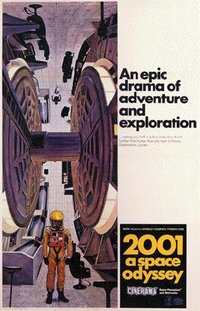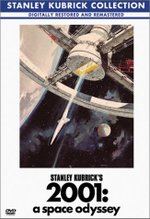2001: A Space Odyssey
2001: A Space Odyssey is an influential 1968 science fiction film directed by Stanley Kubrick. The story is based in part on various short stories by co-screenwriter Arthur C. Clarke, most notably "The Sentinel" (1951). more...
Kubrick and Clarke collaborated on the screenplay, from which Kubrick created the movie and Clarke wrote the novel version (which eventually grew into the so-called Space Odyssey series of books). For an elaboration of their collaborative work on this project, see The Lost Worlds of 2001, Arthur C. Clarke, Signet., 1972.
The film is notable for combining episodes contrasting high levels of scientific and technical realism with transcendental mysticism. As Arthur C. Clarke wrote in 1972, "Quite early in the game I went around saying, not very loudly, 'MGM doesn't know this yet, but they're paying for the first $10,000,000 religious movie.'" This film won the Academy Award for visual effects in 1968.
Production
2001: A Space Odysssey was shot in Technicolor with a 65mm film negative format. The film process was Super Panavision 70. Although billed as a "Cinerama" production, the film did not employ the Cinerama three camera/three projector process.
Release
The US premiere was on April 2, 1968, at the Uptown Theater in Washington, DC. The UK premiere was on May 10, 1968, at the Casino Cinerama Theater in London. The original roadshow release was in a 70mm projection format with a six-track magnetic soundtrack. The projection aspect ratio was 2.21:1. The film was also released in a 35mm format for general release beginning in the fall of 1968.
The original 70mm release was billed as a "Cinerama" production in theaters such as the Indian Hills Theater in Omaha, Nebraska, which were built for the Cinerama process with a deeply curved screen. In other non-Cinerama theaters the release was simply identified as a "70mm" production.
Reaction
Cast
Synopsis
NOTE: Due to the fact that the film conveys almost all ideas visually and ambiguously, it can be interpreted in many ways. The following synopsis is merely one interpretation.
In early conversations, director Stanley Kubrick and writer Arthur C. Clarke jokingly called their project How the Solar System Was Won, an allusion to the epic 1962 Cinerama film How the West Was Won, which presents a generation-spanning historical epic told in distinct episodes. Like How the West Was Won, 2001 is composed of distinct episodes. Three of the four major sections are introduced with the use of title cards: the lack of a title card between the first and second sections listed below has been seen by some to imply that Dr. Floyd's trip to the Moon and the discovery of TMA-1 merely continue the action of Moon Watcher's discovery of the monolith in the Dawn of Man sequences, without introducing a new phase in the development of humanity. The four sections are:
Read more at Wikipedia.org



